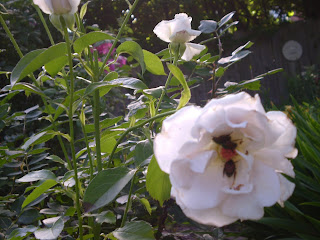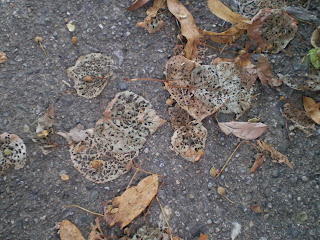I don't know about you, but I'm really inundated with Japanese Beetles this season. According to Ohio State Extension publications, Japanese Beetles usually appear in late June. I've had then since June 9 and I have not had a rose since.
All of this eating can skeletonize leaves and devour complete buds as on this Rose-Of-Sharon.
Japanese Beetle love to eat roses, Linden and Hawthorne trees, and - get this - 300 other plants are on their menu.
To control Japanese Beetles, we need to understand the life cycle of this abundant and important landscape pest. The adult female deposits her eggs in the soil. The eggs hatch and molt within 8 -14 days. This is the first instar of the larval state. The second instar molts in another 7-25 days, and matures within the next 45 days. The third instar matures in late September. And by October, the larvae goes deep into the soil to overwinter.
During the second and third instar is when the 'white grub' feeds. The roots of plants and organic material in the soil are food of choice. Turf grass roots are particularly susceptible to this guys.
So, how do we protect out gardens, trees, and lawns from this costly damage?
Suggestion 1 - Hand pick off adult beetles when they first appear. This will discourage them from emitting a pheromone to attract others. Without partners, there is no mating; no mating no eggs;, no eggs, no larvae to eat your lawn, and no larvae to overwinter for the spring emergence of new adult Japanese Beetles.
Suggestion 3 - Use Traps - The bags will lure Japanese Beetles to them. The bugs get in but can not get out. The down side to me is 'they lure Japanese Beetles'. This method can only be effective if the whole neighborhood participates.
Suggestion 4 - And for those of you who know me this is a tough one for me to promote - Chemical spraying. Products like Sevin or Orthene will kill. Repeat spray every 7 - 10 days. (Remember, the females may be reemerging from laying eggs in the soil and missed the initial application!).
Neem oil sprays have good results too. They, again, need to be repeated every 7 - 10 days.
Bayer Advanced Tree and Shrub is a systemic product which means it works in the plant, up through the roots and into the limbs and leaves. To be effective, Bayer Advanced needs to be applied at least 20 days prior to the expected arrival of the Japanese Beetles.
Lawn products that have shown good results on white grubs have the ingrediant ' Merit'. These can be applied as early as June and July for the residual in the soil will last.
Two other controls I'm familiar with are organic options. One is St. Gabriel Labs, Milky Spore.
The other organic solution is to apply beneficial nematodes. These microscopic organisms invade the white grubs and kill them. This needs to be applied when the grubs are active - August - to be effective. With an easy hose-end sprayer, this is the easiest for me.
So, I've had enough of these creatures. Bring out the arsenal! And Hope! Next year has got to be better.
Check out fellow blogger, Carol Cichorski's article of July 5, 2012, on Japanese Beetles at her site Oh What a Beautiful Garden - Chicagoland.









No comments:
Post a Comment